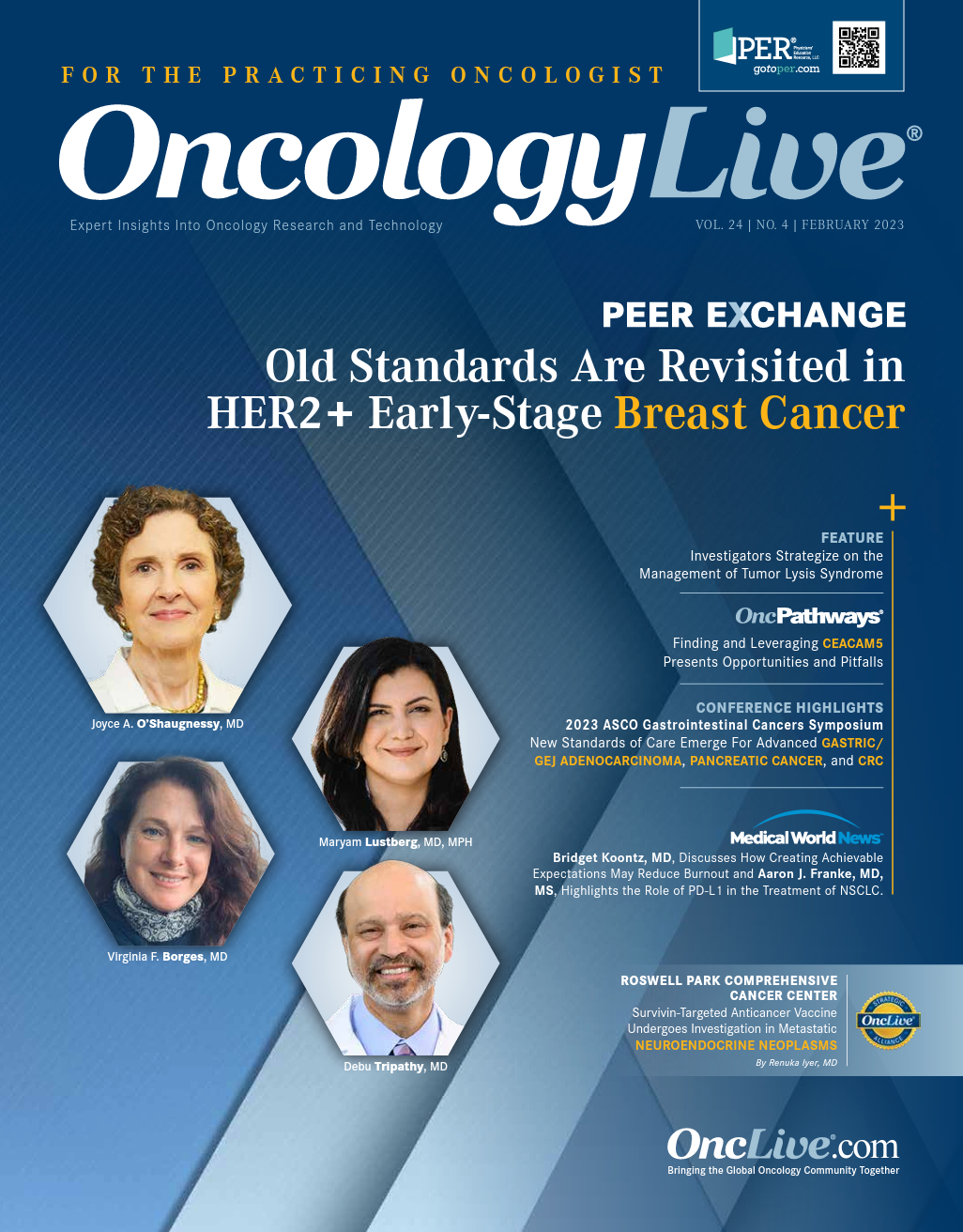Publication
Article
Oncology Live®
The Implications of the Underappreciated, Evolving View of Cancer as a Chronic Illness
Author(s):
Successful manipulation of the immune system to achieve regression of cancer, long an unfulfilled goal of oncologic investigation, is an ever-increasing reality in multiple clinical settings.
Maurie Markman, MD

It is difficult to overstate the remarkable progress made in translating our understanding of cancer biology into beneficial therapeutic strategies for patients with malignant disease. Hardly a week or even a day goes by without a report published in a peer-reviewed journal or presented at a national cancer meeting about a new and possibly quite novel antineoplastic agent demonstrating an improved outcome (objective response rate, progression-free survival, overall survival) compared with an existing standard of care.
Successful manipulation of the immune system to achieve regression of cancer, long an unfulfilled goal of oncologic investigation, is an ever-increasing reality in multiple clinical settings. Checkpoint inhibitors, chimeric antigen receptor T-cell strategies, immune conjugates, and bispecific antibodies represent just some of the novel approaches to cancer management. Targeted therapies, based on the presence of specific molecular abnormalities within individual tumors, represent another exciting strategy that have become an increasingly routine approach to treatment.
The enormous effect of decades of advances in prevention (eg, tobacco control), screening, and therapeutics has been emphasized in a recent publication from the American Cancer Society, which noted that the cancer death rate in the United States decreased 33% from 1991 to 2020.1 This translates into “an estimated 3.8 million deaths averted.”1
Unfortunately, an accompanying component of this revolution in cancer care is the well-documented escalation in the costs of these new therapeutics, resulting in serious financial toxicity for an expanding proportion of patients and their families. Further, there appears to be no meaningful barriers to the continuation, and even acceleration, of this distressing process.
The existing medical literature contains considerable content regarding the issues highlighted above, including several evolving approaches, such as “maintenance therapy.” However, in the opinion of this commentator, what has been surprisingly lacking in written or verbal discussions of the future of oncology is the evolution of cancer as a serious but more chronic disease process with critically relevant implications for patients, families, and society.
Cancer as a Chronic Illness
Before proceeding, it is critical to understand what the term chronic means in the context of cancer management. Webster’s New Twentieth Century Dictionary, second edition, defines the term as “continuing a long time; also, recurring, as a disease; or having had an ailment or habit for a long time.” Thus, chronic implies a prolonged duration or a recurring process. It is essential to note there is nothing in this definition that implies a chronic illness is not serious, potentially debilitating, or fatal. One only needs to consider the well-recognized, potentially life-threatening complications associated with diabetes, perhaps the classic chronic medical condition.
No specific duration of a disease qualifies a particular malignant condition as chronic. However, it is reasonable to suggest characterizing the disease process for many patients as being more chronic than acute in settings where multiple lines of active therapy known to favorably affect survival are available and routinely employed.
What are the implications of this evolving view of cancer and its management? The question is important and complex, with 3 specific issues that need highlighted: treatment-related toxicities, cost of care, and revisions to commonly used terminology.
First, it is essential that the oncology community begins a serious discussion regarding its evaluation of treatment- related toxicity. Based on multidecade experience with cytotoxic chemotherapy—often demonstrating limited effectiveness beyond a single line or, at most, 2 lines of treatment for metastatic disease—the focus has been on observing and managing short-term adverse effects (eg, emesis, bone marrow suppression). Even when longer-term or more cumulative toxicities are considered, little attention has been given to the possible influence of a preceding therapeutic plan on the utility and harm of subsequently delivered agents.
A classic example of this was demonstrated in data from a phase 3 randomized trial that compared second-line, single-agent pegylated liposomal doxorubicin (PLD) with topotecan in patients with potentially platinum-sensitive recurrent ovarian cancer.2 Although only a small difference (of 5.6 weeks) in median progression-free survival was observed between the agents in favor of PLD, patients randomly assigned to PLD experienced a rather striking 36.9-week improvement in overall survival vs those on topotecan; this was most likely because women treated with second-line topotecan experienced excessive and persistent bone marrow suppression that prevented them from subsequently receiving third-line platinum-based treatment (to which the cancer may have still been sensitive).2 In a more chronic disease management schema, it is essential to consider the longerterm toxic effects on subsequent therapy.
Other examples of concerns about the potential effect of multiple lines of therapy on the process of more chronic management include the risk of myelodysplastic syndrome with the use of PARP inhibitors as a maintenance strategy or the cumulative influence of antineoplastic agents that may result in neurotoxic effects (eg, platinum agents, taxanes).
A second issue associated with viewing cancer as a more chronic process is cost of care. A devastating reality is that monthly treatments of advanced cancer can cost upward of $10,000 to $20,000 per month. The financial impact on patients, families, employers, payers, or society as a whole must be considered as therapies move from defined treatment cycles (ie, 4 to 6 cycles of costly therapy delivered as a standard-of-care adjuvant strategy or an active regimen for metastatic cancer given for a period of less than 4 to 6 months) vs a maintenance therapy strategy or multiple lines of treatment administered monthly for several years or longer.
Finally, the cancer community must begin to appreciate how the terribly outdated terminology used to categorize the status of a patient’s progress during their cancer journey negatively affects the discussions highlighted above. The current decades-old staging convention makes it difficult to fully describe and appropriately articulate the overall goals of management and the specific impact of a short-term condition (cancer viewed as an “acute illness”) vs a longer-term condition (cancer viewed as a “chronic disease”) to individual patients and their families, the cancer community, payers, regulators, public policy experts, and governmental officials.
Remarkably, with all the advances in cancer management and improvements in survival, essentially nothing has changed in how the diagnosis, initial treatment, and future developments are explained in the cancer staging system. There is an initial stage and then potentially recurrent or metastatic disease, with little formal detailed acknowledgement or a clearly articulated picture of the potential for a long cancer journey.
A major modification of the established cancer staging criteria to recognize the reality of more chronic management in the oncology sphere will likely permit a more transparent discussion with patients and an essential societal debate regarding the provision of—and payment for— optimal cancer care.
Maurie Markman, MD, is president of Medicine & Science at Cancer Treatment Centers of America, a part of City of Hope.
References
- Siegel RL, Miller KD, Wagle NS, Jemal A. Cancer statistics, 2023. CA Cancer J Clin. 2023;73(1):17-48. doi:10.3322/caac.21763
- Gordon AN, Fleagle JT, Guthrie D, Parkin DE, Gore ME, Lacave AJ. Recurrent epithelial ovarian carcinoma: a randomized phase III study of pegylated liposomal doxorubicin versus topotecan. J Clin Oncol. 2001;19(14):3312-3322. doi:10.1200/JCO.2001.19.14.3312
























%20(2)%201-Recovered-Recovered-Recovered-Recovered-Recovered-Recovered-Recovered-Recovered-Recovered-Recovered-Recovered-Recovered-Recovered-Recovered-Recovered-Recovered-Recovered.jpg?fit=crop&auto=format)
%20(2)%201-Recovered-Recovered-Recovered-Recovered-Recovered-Recovered-Recovered-Recovered-Recovered-Recovered-Recovered-Recovered-Recovered-Recovered-Recovered-Recovered-Recovered.jpg?fit=crop&auto=format)
